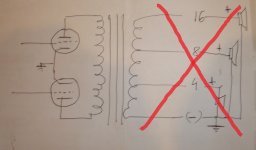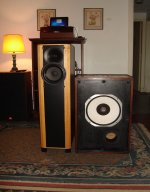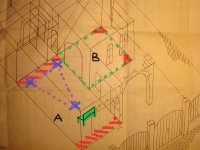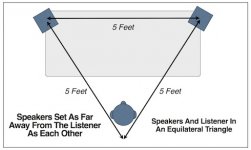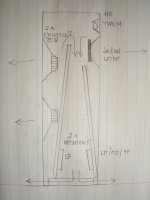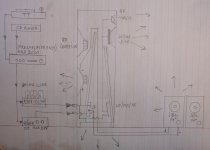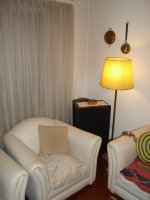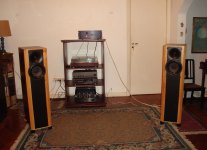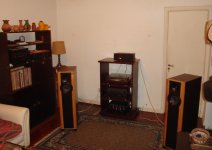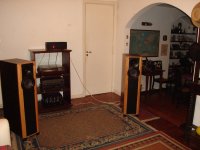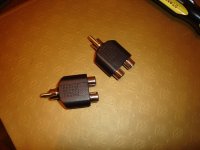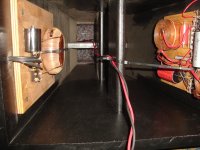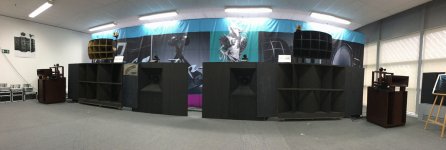For tube amps, if we choose the "50% generator efficiency ratio" we can achieve so much distortion. So, the loadline is based upon best match to the output tube. And results in different Damping Factor (DF) for different taps, so in principle the DF is higher and THD is lower with 4R tap. More wattage is expected for low loads with 4R tap too (but with the consequent power redution for lighter loads).
At least for my tastes, my TQWT sounded the best with moderate to high DF.
At least for my tastes, my TQWT sounded the best with moderate to high DF.
For tube amps, if we choose the "50% generator efficiency ratio" we can achieve so much distortion. So, the loadline is based upon best match to the output tube. And results in different Damping Factor (DF) for different taps, so in principle the DF is higher and THD is lower with 4R tap. More wattage is expected for low loads with 4R tap too (but with the consequent power redution for lighter loads).
At least for my tastes, my TQWT sounded the best with moderate to high DF.
Thanks friend, I'll leave it connected then in four ohms. What would happen if I use 8 ohms for the subwofer sector (very pretentious this phrase ) and 4 ohms for the rest ?
The only trouble with this is that the levels for JA8008 and rear speakers will become mismatched in level.Thanks friend, I'll leave it connected then in four ohms. What would happen if I use 8 ohms for the subwofer sector (very pretentious this phrase ) and 4 ohms for the rest ?
Hi DiyBras 🙂
I have been reading a bit to refresh my knowledge about the connection of valvular amplifiers and I have found this sentence:
" We must never again use the outputs of different impedances in a valve amplifier. "
and :
" In amplifiers to valves always respect the impedances and connect that they coincidate . Golden rule. "
Conexión de altavoces y amplificadores: impedancias | Servicio técnico de amplificadores y equipos de audio
So I decided to go deep and I found this, (chapter 5 on transformers) but I do not have the knowledge or the desires to make so many calculations... 🙁
Radiotron Designer's Handbook, Fourth Edition
http://www.tubebooks.org/Books/RDH4.pdf
So I am with some doubts. Prima Luna (my amplifier) advises to test the different connection terminals to achieve the sound that suits us best. Regardless of the actual impedance of the bafle. I have done it previously with my vintage JBL (8 ohms) although I do not believe much in it, just to confirm my skepticism ... I think the correct thing technically is primordial, then we can discuss about the quality Of the sound .....
Also they recommended at the time a change of fuse of the power supply for one of type audiofile, ensuring differences in the sound ..... you can believe that I got them here in Argentina, (I had to buy 100 units, and the rest I offered them on the website of Prima Luna who needs them, as a gift, of course) and for my ears there is no improvement in sound at all ..... but many people buy special power cables that cost money ! : Eek: To filter the impurities coming from the household voltage network ! I thought that a good filtering at the output of the power transformer was all that was needed ..... here I did not spend my money, since, it is not the prices of the fuses .....
In short, that each one be happy as he pleases, as long as he does not harm the neighbor, of course ......
😀
I have been reading a bit to refresh my knowledge about the connection of valvular amplifiers and I have found this sentence:
" We must never again use the outputs of different impedances in a valve amplifier. "
and :
" In amplifiers to valves always respect the impedances and connect that they coincidate . Golden rule. "
Conexión de altavoces y amplificadores: impedancias | Servicio técnico de amplificadores y equipos de audio
So I decided to go deep and I found this, (chapter 5 on transformers) but I do not have the knowledge or the desires to make so many calculations... 🙁
Radiotron Designer's Handbook, Fourth Edition
http://www.tubebooks.org/Books/RDH4.pdf
So I am with some doubts. Prima Luna (my amplifier) advises to test the different connection terminals to achieve the sound that suits us best. Regardless of the actual impedance of the bafle. I have done it previously with my vintage JBL (8 ohms) although I do not believe much in it, just to confirm my skepticism ... I think the correct thing technically is primordial, then we can discuss about the quality Of the sound .....
Also they recommended at the time a change of fuse of the power supply for one of type audiofile, ensuring differences in the sound ..... you can believe that I got them here in Argentina, (I had to buy 100 units, and the rest I offered them on the website of Prima Luna who needs them, as a gift, of course) and for my ears there is no improvement in sound at all ..... but many people buy special power cables that cost money ! : Eek: To filter the impurities coming from the household voltage network ! I thought that a good filtering at the output of the power transformer was all that was needed ..... here I did not spend my money, since, it is not the prices of the fuses .....
In short, that each one be happy as he pleases, as long as he does not harm the neighbor, of course ......
😀
Last edited:
Fuses... I don't comment about it🙄😀Hi DiyBras 🙂
I have been reading a bit to refresh my knowledge about the connection of valvular amplifiers and I have found this sentence:
" We must never again use the outputs of different impedances in a valve amplifier. "
and :
" In amplifiers to valves always respect the impedances and connect that they coincidate . Golden rule. "
Conexión de altavoces y amplificadores: impedancias | Servicio técnico de amplificadores y equipos de audio
So I decided to go deep and I found this, (chapter 5 on transformers) but I do not have the knowledge or the desires to make so many calculations... 🙁
Radiotron Designer's Handbook, Fourth Edition
http://www.tubebooks.org/Books/RDH4.pdf
So I am with some doubts. Prima Luna (my amplifier) advises to test the different connection terminals to achieve the sound that suits us best. Regardless of the actual impedance of the bafle. I have done it previously with my vintage JBL (8 ohms) although I do not believe much in it, just to confirm my skepticism ... I think the correct thing technically is primordial, then we can discuss about the quality Of the sound .....
Also they recommended at the time a change of fuse of the power supply for one of type audiofile, ensuring differences in the sound ..... you can believe that I got them here in Argentina, (I had to buy 100 units, and the rest I offered them on the website of Prima Luna who needs them, as a gift, of course) and for my ears there is no improvement in sound at all ..... but many people buy special power cables that cost money ! : Eek: To filter the impurities coming from the household voltage network ! I thought that a good filtering at the output of the power transformer was all that was needed ..... here I did not spend my money, since, it is not the prices of the fuses .....
In short, that each one be happy as he pleases, as long as he does not harm the neighbor, of course ......
😀
About impedance matching: is a matter of being at correct tube loadline. Less ohms than tap offering (like 4R speaker in 8R tap) one can lose Watts and most of time THD will rise, and DF reduces, as explained before. Only with rare amplifiers with spare power, using more tubes than trivial, we can forget about tube llifetime. With higher impedance (8R speaker in 4R tap), one can obtain more class A and less distortion and more DF, in most cases. In some rare cases, the THD/HD in less with lower loadline, but in almost all cases the higher order harmonics will rise. With low impedance, some tubes amplifiers with tubes at limit will make tubes suffer. The mean choice is 8R in 8R tap, for a best compromise. But since speakers typically have far more THD/HD than most amplifiers, sometimes this is a moot point. Or sometimes the incorrect matching produces a HD cancellation, like one explored by Audiopax, by the late Eduardo de Lima.
Most speakers, like D/TQWT have a wild variyng impedance vs frequency, so even pluging the "6R speaker" at 8R tap will produce bad effects only at certain freq ranges. Probably the bigger voltage possible at higher ohm tap output will produce a higher perceived maximum power, unless the music note hit exactly at minimum impedance.
Or better yet, if we listen at civilized manner and amplifier is from a good maker, is possible to follow PrimaLuna recommendations.
But DF will always plays a role, independently from HD/power etc..
Confusing? Well, is the analog "compromise" world!
Last edited:
Hi Diybras
Thanks for your considerations, and thanks too for the link, very very interesting ... SET amplifiers that can deliver up to 130 watts, timbre control circuits, and maybe some other revolutionary innovations that escape me in a first reading to bird flight .
I did not know all these advances, it seems that the analog world of vacuum tubes is (as you say) prone to some confusion ....
But I want to clarify something that seems to me in the inkwell, so that it will not be misunderstood by those who just make their first weapons in the subject vacuum tubes.
See attached.
Such connections should not be made in a conventional vacuum tube amplifier coupled with output transformers. Only one winding at a time must be connected. If someone is encouraged to calculate the total impedance results in this hypothetical case, I think they would win a Nobel Prize .... I can barely with the accounts of the supermarket ...😀
Also, the speaker terminals should not be connected to the amplifier if the amplifier is switched ON.
The first thing a beginner should take into account with regard to speaker connection is that what is used for vacuum tubes is not good for solid state and vice versa.
A short circuit in the line of speakers is deadly for a solid state count if it does not have protection circuits, and in many cases, even if they exist, they do not work well. On the other hand, to leave condos with a one a umaitma, the impedance is infinite and will not circulate current. But in a valvular amplifier, the plate circuit will not be able to transport in its energy from the primary to the secondary of the transformer. (I have seen them) that will remind us of the tests that we made with the cables of bujías in the cars to know if there was or not high tension .... The destruction of the valve and / or its associated mois is just around the corner, as we say here.
Well, enough of can and now to listen to music...🙂
Thanks for your considerations, and thanks too for the link, very very interesting ... SET amplifiers that can deliver up to 130 watts, timbre control circuits, and maybe some other revolutionary innovations that escape me in a first reading to bird flight .
I did not know all these advances, it seems that the analog world of vacuum tubes is (as you say) prone to some confusion ....
But I want to clarify something that seems to me in the inkwell, so that it will not be misunderstood by those who just make their first weapons in the subject vacuum tubes.
See attached.
Such connections should not be made in a conventional vacuum tube amplifier coupled with output transformers. Only one winding at a time must be connected. If someone is encouraged to calculate the total impedance results in this hypothetical case, I think they would win a Nobel Prize .... I can barely with the accounts of the supermarket ...😀
Also, the speaker terminals should not be connected to the amplifier if the amplifier is switched ON.
The first thing a beginner should take into account with regard to speaker connection is that what is used for vacuum tubes is not good for solid state and vice versa.
A short circuit in the line of speakers is deadly for a solid state count if it does not have protection circuits, and in many cases, even if they exist, they do not work well. On the other hand, to leave condos with a one a umaitma, the impedance is infinite and will not circulate current. But in a valvular amplifier, the plate circuit will not be able to transport in its energy from the primary to the secondary of the transformer. (I have seen them) that will remind us of the tests that we made with the cables of bujías in the cars to know if there was or not high tension .... The destruction of the valve and / or its associated mois is just around the corner, as we say here.
Well, enough of can and now to listen to music...🙂
Perfect! If one put a 8R speaker in a 8R tap and at same time put one of 4R in the 4R tap, is equivalent to put two 4R speakers at 4R tap OR two 8R speakers in a 8R tap, but this trick works if is a 4R Tweeter with crossover at 4R tap and a 8R woofer at 8R tap with crossover, for level matching, for example (or vice-versa).I forgot the attachment
But valve amps only damage the output trafo with HV without load if the feedback phase margin is marginal. With proper settp, is possible to operate stable without load (I test my amplifiers this manner, too). My PL509 has a bunch of feedback and don't oscillate with infinite Ohm load.
Valve amplifiers without feedback dont't destroy the output trafo due to absence of feedback to mess things.
""Well, enough of can and now to listen to music..."" I agree! Time to listen!🙂
I keep listening and comparing, I think I miss the first two octaves ....😉
I have not found the first two octaves ( for this we need
a subwofer,there are no free lunches, see here ...)
http://www.diyaudio.com/forums/subwoofers/303987-vintage-jbl-subwofer.html
, but if I found the optimal listening place in my room.
New phenomena occur here, since the replacement of my vintage JBL by DTQWT have appeared blind spots (? Modes) in the sound perception of bass tones.
In other words, what used to be a bass reflex speaker charging and tuning through the front of the cabinet, does not fit a double horn with load for front, back and floor. Tuned by the mouth of the horn in its encounter with the floor, as to increase the differences.
The areas marked in red are the points where the bass gain is strong, I calculate about 6 db minimum, I have no instruments to measure this nor do I intend to do so. I only trust my ears and experience. My intention is not to experiment, but to listen as best as possible.
The sweet spot to perceive depth and wide sound scene, expanded to the sides besides (see link, thank you Lynn)
Speaker Location and Image Quality
The Ariel, Part II
and not a hole in the center, is pointing the cabinets to a point located right in front of our feet, physically speaking. (In my case, they are 60/70 cm)
This changed the sound scene a lot. The traditional here does not work as well.
( see attached )
It is an atypical room, with high ceilings and a lateral habitat to the right, it is the zone dotted in green. ( See zone A and B . Zone B is located 50 cm below the area A and there the roof has lower height )
Any comments will be appreciated, regards !🙂
Attachments
Last edited:
I keep listening and comparing, I think I miss the first two octaves ....😉
There are news! 🙂Very interesting and good,
 I am enjoying a new sound with great satisfaction, the builders of Dtqwt/ II must be attentive, today I have achieved the bass extension that I wanted.
I am enjoying a new sound with great satisfaction, the builders of Dtqwt/ II must be attentive, today I have achieved the bass extension that I wanted.I'll tell you all ...

Hi earlk
I canceled the Eminence DeltaLite 2510II. (higher)
Instead it works a 14-inch JBL LE14C speaker that has lower FS and in its dedicated 80 liter cabinet achieves a bass extension that adds to that of the DTQWTII.
Vintage JBL for subwofer
The upper Eminence speaker is disconnected acting as a passive radiator.
I'll be attaching graphics as I develop the idea.
Thanks for your interest ! 😉
I canceled the Eminence DeltaLite 2510II. (higher)
Instead it works a 14-inch JBL LE14C speaker that has lower FS and in its dedicated 80 liter cabinet achieves a bass extension that adds to that of the DTQWTII.
Vintage JBL for subwofer
The upper Eminence speaker is disconnected acting as a passive radiator.
I'll be attaching graphics as I develop the idea.
Thanks for your interest ! 😉
Attachments
Last edited:
In general "normal" sized TQWT don't have the "normal" low freq. extension like people are used to (33~40Hz). In practice seems to start at 43~45Hz or so. My home has a great room gain in low frequencies and I don't miss "half octave" most times with almost all music, but I plan to build a active two 8" TL for suplying 20~45Hz (TL taper's invesely if compared with a TQWT, interesting...). For most music for sure I don't switch on the sub. In fact, some "woolly" recorded music actually benefit from a less than good very low freq. response (some studio people need to learn how to microphone correctly the drum kit...)
The DTQWT don't make low freq. extension lower in comparision with a TQWT, since max line lenght is same; only the max low freq handling or so (in my home I don't miss the extra woofers; in reality sometimes I desire to put a second tweeter, that's it 😛 ). The extended "monster" DTQWT will reproduce all without a need for sub.
The DTQWT don't make low freq. extension lower in comparision with a TQWT, since max line lenght is same; only the max low freq handling or so (in my home I don't miss the extra woofers; in reality sometimes I desire to put a second tweeter, that's it 😛 ). The extended "monster" DTQWT will reproduce all without a need for sub.
Here all connections
The SS amplifier is a vintage RCA diy 70 watts rms per channel, a classic of the 70's. 2 x 40638 RCA quasi complementary at the output, are transistors equivalent to the Motorola 2N3055. If, of course, a 300-watt modern class D amplifier, connected to a special speaker for subwoofer, 18 inches and housed in a good cabinet would be better ....😀 It will come that step, a plate amplifier, and with a selection of frequency crossing is ideal. But, this is what there is, and the sound result is far superior to my previous configuration. Lots of fun, and WAF lets me do it, what more can I ask for.
This power amplifier is used directly to power the bass sector with the two speakers connected in series, the same electrical impedance is retained (Eminence and JBl have 8 ohms of impedance), the acoustic impedance is not altered because the added speaker of 14 "Works in its own compartment and the disconnected Eminence remains in place acting as a passive radiator.
The amplifier Nad 3020 has good output signal level (mV) in its preamplifier section, and the shunt with a Y-connector does not significantly change the input impedances to the respective amplifiers.
https://www.hifiengine.com/manual_library/nad/3020.shtml
The JBL speakers are used directly in the low frequency sector, the DTQWTII used first order cross over works perfectly with the two speakers in series. Only the JBL is separated and away from the main cabinet, to my surprise, the adaptation is perfect, sectors have disappeared where there were behaviors with bass nodes and now you walk around the room and the bass sounds are of equal intensity!
A little experimentation is necessary to achieve the harmony of the set, for them it is important to have, as in my case, independent volume controls on each amplifier to match the emitted DBs, and then the general volume is managed with the control of the pre NAD 3020. In addition, I have tone controls if I want to play a little, edit old recordings, and I can apply Loudness when I listen at low volume. Anyway, everything must be balanced flat.
In the next post, respond to Diybrass and upload photos ! 🙂 I must go to fulfill my daily obligations .......🙄
The SS amplifier is a vintage RCA diy 70 watts rms per channel, a classic of the 70's. 2 x 40638 RCA quasi complementary at the output, are transistors equivalent to the Motorola 2N3055. If, of course, a 300-watt modern class D amplifier, connected to a special speaker for subwoofer, 18 inches and housed in a good cabinet would be better ....😀 It will come that step, a plate amplifier, and with a selection of frequency crossing is ideal. But, this is what there is, and the sound result is far superior to my previous configuration. Lots of fun, and WAF lets me do it, what more can I ask for.
This power amplifier is used directly to power the bass sector with the two speakers connected in series, the same electrical impedance is retained (Eminence and JBl have 8 ohms of impedance), the acoustic impedance is not altered because the added speaker of 14 "Works in its own compartment and the disconnected Eminence remains in place acting as a passive radiator.
The amplifier Nad 3020 has good output signal level (mV) in its preamplifier section, and the shunt with a Y-connector does not significantly change the input impedances to the respective amplifiers.
https://www.hifiengine.com/manual_library/nad/3020.shtml
The JBL speakers are used directly in the low frequency sector, the DTQWTII used first order cross over works perfectly with the two speakers in series. Only the JBL is separated and away from the main cabinet, to my surprise, the adaptation is perfect, sectors have disappeared where there were behaviors with bass nodes and now you walk around the room and the bass sounds are of equal intensity!
A little experimentation is necessary to achieve the harmony of the set, for them it is important to have, as in my case, independent volume controls on each amplifier to match the emitted DBs, and then the general volume is managed with the control of the pre NAD 3020. In addition, I have tone controls if I want to play a little, edit old recordings, and I can apply Loudness when I listen at low volume. Anyway, everything must be balanced flat.
In the next post, respond to Diybrass and upload photos ! 🙂 I must go to fulfill my daily obligations .......🙄
Attachments
Diybras :
I agree with you, you're right !
DtqwtII has more "lower" than TqwtII , says the designer and I check it by disconnecting the back sector 2x Eminence. The push pull effect is correct and works well. But I think the mistake is confusing subwofer with low frequencies. This looks like a pun, but it is not. The difference in sound pressure between the bass notes (let's face it and talk about 30 hertz, let the golden ears all the rest of down) and those that are above 40/50 hertz, is important. The graphs show drops of 10 db below 40 hertz, and that is almost a third in the power applied to those frequencies. (Wow, it's now fashionable to use the CSD, it would be nice for someone to do the scan over the entire audible spectrum of all the drivers running, not just for individual drivers like the manufacturers.) There is no free lunch here, they go to subwofer dedicated to this very special sector.
But, as I said before, in my case and particular room, the experiment has performed very well, without becoming a subwoof once again. The bi-amplification theme is easy with watertight compartments for the bass and mid / treble sectors, but in the DTQWTII .... it was a big unknown! ..... because all the drivers (except the tweeter) interact with each other, included middle range, so important.
I hope to see some photos of your subwofers and tell us what it is.
And tell us about your current project, too!
I agree with you, you're right !
DtqwtII has more "lower" than TqwtII , says the designer and I check it by disconnecting the back sector 2x Eminence. The push pull effect is correct and works well. But I think the mistake is confusing subwofer with low frequencies. This looks like a pun, but it is not. The difference in sound pressure between the bass notes (let's face it and talk about 30 hertz, let the golden ears all the rest of down) and those that are above 40/50 hertz, is important. The graphs show drops of 10 db below 40 hertz, and that is almost a third in the power applied to those frequencies. (Wow, it's now fashionable to use the CSD, it would be nice for someone to do the scan over the entire audible spectrum of all the drivers running, not just for individual drivers like the manufacturers.) There is no free lunch here, they go to subwofer dedicated to this very special sector.
But, as I said before, in my case and particular room, the experiment has performed very well, without becoming a subwoof once again. The bi-amplification theme is easy with watertight compartments for the bass and mid / treble sectors, but in the DTQWTII .... it was a big unknown! ..... because all the drivers (except the tweeter) interact with each other, included middle range, so important.
I hope to see some photos of your subwofers and tell us what it is.
And tell us about your current project, too!
About sub with the TQWT I've played a little some time ago with a 55L 12" sealed box before I put it in the car trunk. Great with proper recordings, but this sub is not on par with the TQWT (this 12" driver is "slow" = distorted).
About the TL, I have only the 8" SEAS drivers for now... are a leftover from a failed project 😡 ...and some preliminary plans/idea. I need to decide if I put the two 8" in same TL with proper line area or build two 8" TL and so results in a stereo sub (I'm inclined to build only one). Since I recently travelled to Munich I need to wait before I spend again...
I've played with TL 10 years ago and I think the bass "interessant" and not equal to a BR (Bass Reflex), at least for small drivers. Unfortunately, for 20Hz a TL will be a "real estate" but for a TQWT owner space is not a problem
I thinking now about your 14" speakers... that huge cone (Sd)... 🙂
About the TL, I have only the 8" SEAS drivers for now... are a leftover from a failed project 😡 ...and some preliminary plans/idea. I need to decide if I put the two 8" in same TL with proper line area or build two 8" TL and so results in a stereo sub (I'm inclined to build only one). Since I recently travelled to Munich I need to wait before I spend again...
I've played with TL 10 years ago and I think the bass "interessant" and not equal to a BR (Bass Reflex), at least for small drivers. Unfortunately, for 20Hz a TL will be a "real estate" but for a TQWT owner space is not a problem

I thinking now about your 14" speakers... that huge cone (Sd)... 🙂
Subwoofer experiment photo show 😎
Will not be too many ? 😱
Will not be too many ? 😱
Attachments
-
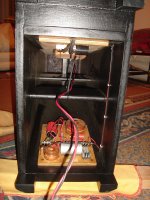 DSC00206.JPG763.7 KB · Views: 111
DSC00206.JPG763.7 KB · Views: 111 -
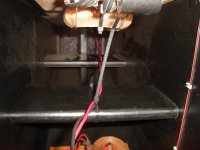 DSC00205.JPG427.6 KB · Views: 101
DSC00205.JPG427.6 KB · Views: 101 -
 DSC00201.jpg414.9 KB · Views: 94
DSC00201.jpg414.9 KB · Views: 94 -
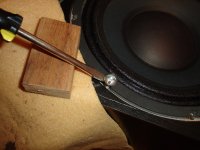 DSC00203.JPG655.3 KB · Views: 104
DSC00203.JPG655.3 KB · Views: 104 -
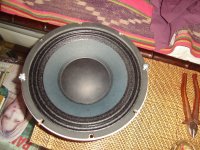 DSC00195.JPG940.7 KB · Views: 124
DSC00195.JPG940.7 KB · Views: 124 -
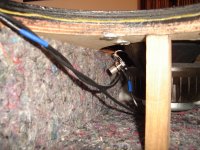 DSC00193.JPG585.9 KB · Views: 115
DSC00193.JPG585.9 KB · Views: 115 -
 DSC00190.JPG741.5 KB · Views: 113
DSC00190.JPG741.5 KB · Views: 113 -
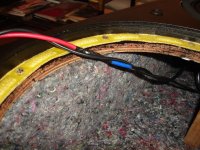 DSC00187.JPG782.7 KB · Views: 253
DSC00187.JPG782.7 KB · Views: 253 -
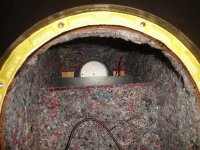 DSC00186.JPG847.8 KB · Views: 238
DSC00186.JPG847.8 KB · Views: 238 -
 DSC00180.JPG703.3 KB · Views: 245
DSC00180.JPG703.3 KB · Views: 245
About the TL, I have only the 8" SEAS drivers for now... are a leftover from a failed project 😡 ...and some preliminary plans/idea. I need to decide if I put the two 8" in same TL with proper line area or build two 8" TL and so results in a stereo sub (I'm inclined to build only one). Since I recently travelled to Munich I need to wait before I spend again...
I've played with TL 10 years ago and I think the bass "interessant" and not equal to a BR (Bass Reflex), at least for small drivers. Unfortunately, for 20Hz a TL will be a "real estate" but for a TQWT owner space is not a problem
I thinking now about your 14" speakers... that huge cone (Sd)... 🙂
If the idea is to use your eight-inch Seas speakers, maybe here you find some information that can help you decide.
How to Get Better Bass Part 7 - Audiophile Review
A folded TL seems to be an excellent choice if there are space issues, and if not, great SD can help a lot, that's true .... but great quality speakers cost a lot of money! Do the Selenium speakers manufactured in Brazil have the same quality as JBL Usa? Maybe you find a good model near you, a suitable box and an amplifier with DSP Inuke and you are touching the sky with your hands .....😀
I've heard 2x18 inch´s JBL subwofers as a complement to JBl Everest DD66000, and the experience was devastating, sub-bass on the body level without being aggressive, that presence .....
I imagine that at the fair in Munich was not JBL but I read that people were very excited listening to a vintage system with horns ..... ahhhhh, that was the top sound of my youth !!! I would have liked to be there, I hope you enjoyed it. 😉
Munich-2017
Attachments
- Home
- Loudspeakers
- Multi-Way
- DTQWTII from Argentina
